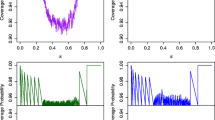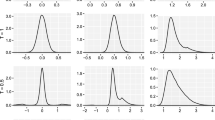Abstract
A randomized two treatment allocation design, conducted in two stages, is proposed for a class of continuous response trials. Patients are assigned to each treatment in equal numbers in the first stage and p value of a test of equality of treatment effects based on these data is used to determine the assignment probability of second stage patients. Relevant properties of the proposed allocation design are investigated and compared with suitable competitors.


Similar content being viewed by others
References
Antognini AB, Giovagnoli A (2005) On the large sample optimality of sequential designs for comparing two or more treatments. Seq Anal 24:205–217
Bandyopadhyay U, Bhattacharya R (2006) An optimal sequential procedure in ethical allocation. J Stat Plan Inference 136:430–446
Bandyopadhyay U, Bhattacharya R (2007) On an ethical cum optimal adaptive allocation design. Statistics 41:471–483
Bandyopadhyay U, Biswas A (2001) Adaptive designs for normal responses with prognostic factors. Biometrika 88:409–419
Biswas A, Bhattacharya R (2009) Optimal response-adaptive designs for normal responses. Biom J 51:193–202
Biswas A, Mandal S (2004) Optimal adaptive designs in phase III clinical trials for continuous responses with covariates. In: Bucchianico ADi, Lauter H, Wynn HP (eds) mODa 7: advances in model-oriented design and analysis. Physica-Verlag, Heidelberg, pp 51–58
Billingsley P (1995) Probability and measure, 3rd edn. Wiley, New York
Coad DS (1992) Some results on estimation for two stage clinical trials. Seq Anal 11:299–311
Colton T (1963) A model for selecting one of two medical treatments. J Am Stat Assoc 58:388–400
Hu F, Rosenberger WF (2006) The theory of response-adaptive randomization in clinical trials. Wiley Interscience, New York
Lehmann EL, Romano JP (2005) Testing statistical hypotheses, 3rd edn. Springer, New York
Rosenberger WF (1993) Asymptotic inference with response-adaptive treatment allocation designs. Ann Stat 21:2098–2107
Rosenberger WF, Lachin JL (2002) Randomisation in clinical trials: theory and practice. Wiley, New York
Zhang L, Rosenberger WF (2006) Response-adaptive randomization for clinical trials with continuous outcomes. Biometrics 62:562–569
Zhang LX, Rosenberger WF (2011) Optimal response-adaptive randomization for clinical trials. In: Pong A, Shein-Chung C (eds) Handbook of adaptive designs in pharmaceutical and clinical development, Chapter 15. CRC Press, Boca Raton
Acknowledgments
The authors would like to thank the anonymous reviewers, the editor and the associate editor for their concerns and insightful comments which led to an improvement over the earlier version of the work.
Author information
Authors and Affiliations
Corresponding author
Appendix
Appendix
Result 4.1
Suppose the response to treatment k has a normal distribution with mean \(\mu _{k}\) and variance \(\sigma _{k}^2\). Then, under any \({{\varvec{\xi }}}=(\mu _A,\mu _B,\sigma _A,\sigma _B)\) with \(\mu _A\ne \mu _B,\) as \(m\rightarrow \infty \)
in probability, according as \(\mu _{A}>\) or \(<\mu _{B}\).
Proof
Consider two statistics \(T_{0m}\) and \(T_{1m}\) where the distribution of \(T_{0m}\) under any \({{\varvec{\xi }}}\) is the same as that of \(T_{m}\) under \(\mu _A=\mu _B.\) Further the distributions of \(T_{1m}\) and \(T_{m}\) are identical under any \({{\varvec{\xi }}}\). Then \(p_m\) can be expressed as \(p_m=P_{\varvec{\xi }}(T_{0m}\ge T_{1m})\). Since the first stage of the allocation design results in independent and identically distributed observations, it follows from the strong law of large numbers (Chapter 6, Billingsley 1995) that as \(m\rightarrow \infty \)
almost surely. Therefore, for any \({{\varvec{\xi }}}\),
almost surely and consequently, as \(m\rightarrow \infty \)
in probability according as \(\mu _{A}>\) or \(<\mu _{B}.\) Hence the result follows. \(\square \)
Note
If the response to treatment k has an exponential distribution with mean \(\mu _{k}\), then for any \((\mu _{A},\mu _{B})\)
almost surely, as \(m\rightarrow \infty .\) The rest of the proof is exactly the same as above with \({\varvec{\xi }}=(\mu _{A},\mu _{B})\).
Result 4.2
If (2.3) holds, then under any \({{\varvec{\xi }}}\) with \(\mu _A\ne \mu _B,\) as \(n\rightarrow \infty \)
in probability, according as \(\mu _{A}>\) or \(<\mu _{B}\).
Proof
Assume \(\mu _{A}>\mu _B\). Then it follows from Result 1 that as \(m\rightarrow \infty \)
in probability. Then from (2.1) and (2.2) it follows easily that
and
as \(n\rightarrow \infty \). Consequently, as \(n\rightarrow \infty \)
in probability. A similar argument leads to the proof with \(\mu _A<\mu _B\). This completes the proof. \(\square \)
Note
The above result holds good for the exponentially distributed responses if we redefine \({\varvec{\xi }}=(\mu _{A},\mu _{B})\).
Rights and permissions
About this article
Cite this article
Bhattacharya, R., Shome, M. A randomized two stage allocation for continuous response clinical trials. Stat Methods Appl 24, 373–386 (2015). https://doi.org/10.1007/s10260-014-0267-6
Accepted:
Published:
Issue Date:
DOI: https://doi.org/10.1007/s10260-014-0267-6




